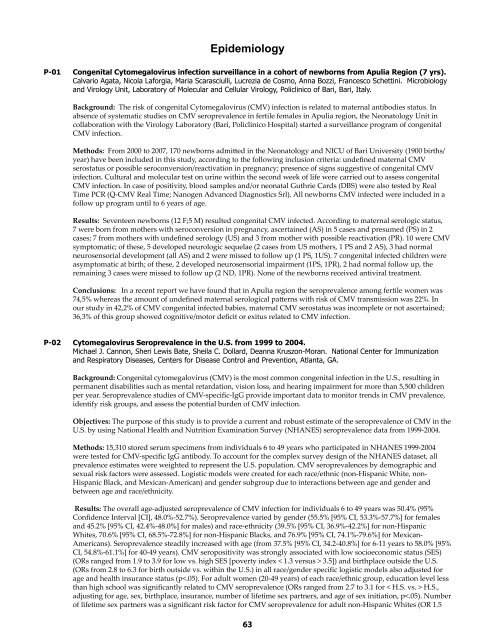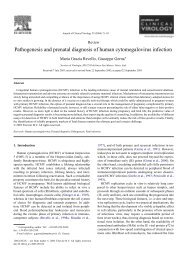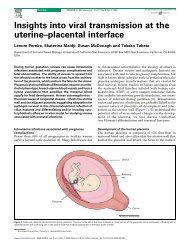Congenital Cytomegalovirus Conference - Congenital CMV ...
Congenital Cytomegalovirus Conference - Congenital CMV ...
Congenital Cytomegalovirus Conference - Congenital CMV ...
You also want an ePaper? Increase the reach of your titles
YUMPU automatically turns print PDFs into web optimized ePapers that Google loves.
Epidemiology<br />
P-01 <strong>Congenital</strong> <strong>Cytomegalovirus</strong> infection surveillance in a cohort of newborns from Apulia Region (7 yrs).<br />
Calvario Agata, Nicola Laforgia, Maria Scarasciulli, Lucrezia de Cosmo, Anna Bozzi, Francesco Schettini. Microbiology<br />
and Virology Unit, Laboratory of Molecular and Cellular Virology, Policlinico of Bari, Bari, Italy.<br />
Background: The risk of congenital <strong>Cytomegalovirus</strong> (<strong>CMV</strong>) infection is related to maternal antibodies status. In<br />
absence of systematic studies on <strong>CMV</strong> seroprevalence in fertile females in Apulia region, the Neonatology Unit in<br />
collaboration with the Virology Laboratory (Bari, Policlinico Hospital) started a surveillance program of congenital<br />
<strong>CMV</strong> infection.<br />
Methods: From 2000 to 2007, 170 newborns admitted in the Neonatology and NICU of Bari University (1900 births/<br />
year) have been included in this study, according to the following inclusion criteria: undefined maternal <strong>CMV</strong><br />
serostatus or possible seroconversion/reactivation in pregnancy; presence of signs suggestive of congenital <strong>CMV</strong><br />
infection. Cultural and molecular test on urine within the second week of life were carried out to assess congenital<br />
<strong>CMV</strong> infection. In case of positivity, blood samples and/or neonatal Guthrie Cards (DBS) were also tested by Real<br />
Time PCR (Q-<strong>CMV</strong> Real Time; Nanogen Advanced Diagnostics Srl). All newborns <strong>CMV</strong> infected were included in a<br />
follow up program until to 6 years of age.<br />
Results: Seventeen newborns (12 F;5 M) resulted congenital <strong>CMV</strong> infected. According to maternal serologic status,<br />
7 were born from mothers with seroconversion in pregnancy, ascertained (AS) in 5 cases and presumed (PS) in 2<br />
cases; 7 from mothers with undefined serology (US) and 3 from mother with possible reactivation (PR). 10 were <strong>CMV</strong><br />
symptomatic; of these, 5 developed neurologic sequelae (2 cases from US mothers, 1 PS and 2 AS), 3 had normal<br />
neurosensorial development (all AS) and 2 were missed to follow up (1 PS, 1US). 7 congenital infected children were<br />
asymptomatic at birth; of these, 2 developed neurosensorial impairment (1PS, 1PR), 2 had normal follow up, the<br />
remaining 3 cases were missed to follow up (2 ND, 1PR). None of the newborns received antiviral treatment.<br />
Conclusions: In a recent report we have found that in Apulia region the seroprevalence among fertile women was<br />
74,5% whereas the amount of undefined maternal serological patterns with risk of <strong>CMV</strong> transmission was 22%. In<br />
our study in 42,2% of <strong>CMV</strong> congenital infected babies, maternal <strong>CMV</strong> serostatus was incomplete or not ascertained;<br />
36,3% of this group showed cognitive/motor deficit or exitus related to <strong>CMV</strong> infection.<br />
P-02 <strong>Cytomegalovirus</strong> Seroprevalence in the U.S. from 1999 to 2004.<br />
Michael J. Cannon, Sheri Lewis Bate, Sheila C. Dollard, Deanna Kruszon-Moran. National Center for Immunization<br />
and Respiratory Diseases, Centers for Disease Control and Prevention, Atlanta, GA.<br />
Background: <strong>Congenital</strong> cytomegalovirus (<strong>CMV</strong>) is the most common congenital infection in the U.S., resulting in<br />
permanent disabilities such as mental retardation, vision loss, and hearing impairment for more than 5,500 children<br />
per year. Seroprevalence studies of <strong>CMV</strong>-specific-IgG provide important data to monitor trends in <strong>CMV</strong> prevalence,<br />
identify risk groups, and assess the potential burden of <strong>CMV</strong> infection.<br />
Objectives: The purpose of this study is to provide a current and robust estimate of the seroprevalence of <strong>CMV</strong> in the<br />
U.S. by using National Health and Nutrition Examination Survey (NHANES) seroprevalence data from 1999-2004.<br />
Methods: 15,310 stored serum specimens from individuals 6 to 49 years who participated in NHANES 1999-2004<br />
were tested for <strong>CMV</strong>-specific IgG antibody. To account for the complex survey design of the NHANES dataset, all<br />
prevalence estimates were weighted to represent the U.S. population. <strong>CMV</strong> seroprevalences by demographic and<br />
sexual risk factors were assessed. Logistic models were created for each race/ethnic (non-Hispanic White, non-<br />
Hispanic Black, and Mexican-American) and gender subgroup due to interactions between age and gender and<br />
between age and race/ethnicity.<br />
Results: The overall age-adjusted seroprevalence of <strong>CMV</strong> infection for individuals 6 to 49 years was 50.4% (95%<br />
Confidence Interval [CI], 48.0%-52.7%). Seroprevalence varied by gender (55.5% [95% CI, 53.3%-57.7%] for females<br />
and 45.2% [95% CI, 42.4%-48.0%] for males) and race-ethnicity (39.5% [95% CI, 36.9%-42.2%] for non-Hispanic<br />
Whites, 70.6% [95% CI, 68.5%-72.8%] for non-Hispanic Blacks, and 76.9% [95% CI, 74.1%-79.6%] for Mexican-<br />
Americans). Seroprevalence steadily increased with age (from 37.5% [95% CI, 34.2-40.8%] for 6-11 years to 58.0% [95%<br />
CI, 54.8%-61.1%] for 40-49 years). <strong>CMV</strong> seropositivity was strongly associated with low socioeconomic status (SES)<br />
(ORs ranged from 1.9 to 3.9 for low vs. high SES [poverty index < 1.3 versus > 3.5]) and birthplace outside the U.S.<br />
(ORs from 2.8 to 6.3 for birth outside vs. within the U.S.) in all race/gender specific logistic models also adjusted for<br />
age and health insurance status (p H.S.,<br />
adjusting for age, sex, birthplace, insurance, number of lifetime sex partners, and age of sex initiation, p





